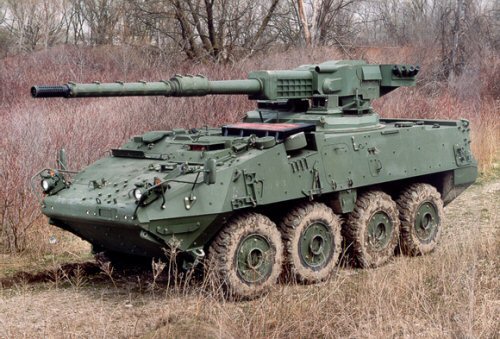Canadian MBTs are MIA
The Canadian Defence Department is spending over half a billion dollars on 66 new combat vehicles in an effort to modernize our armed forces, according to Defence Minister John McCallum. Canada will take delivery of it’s first Mobile Gun System (known as a Stryker in the U.S.), in 2006.
The Stryker has a crew of three, carries a 105 mm General Dynamics tank cannon, .50 calibre and 7.62mm guns, the latest C4ISR equipment, as well as detectors for NBC weapons. The Stryker is built by General Dynamics and General Motors in Alabama, Ohio and London, Ontario.

(Stryker Mobile Gun System)
McCallum has stated that the U.S. has an order of the vehicles in production, and Canada can take advantage of the production run already underway, improving the economy of the Strykers. The last federal budget had set aside $800 million for military equipment, and while the final price tag on the Strykers hasn’t been set, it will be over $500 million, according to McCallum.
{default}The Strykers will be replacing Canada’s aging fleet of Leopard tanks, the only MBT in our nation’s arsenal. The Leopard was developed in Germany, but all Canadian versions were assembled in Canada under license. In 1978, Canada purchased 127 of these tanks, which were considered one of the best in the world at the time. Canada has 114 Leopards in service, including 20 in reserve.

(Leopard C1 A3)
The Canadian military received a report in 1998 suggesting that replacing our Leopards with vehicles such as the Strykers would be a bad idea. But McCallum has stated that our military must transform itself to meet with present and future challenges, to become a "modern, mobile, information age force."
"We have a sound plan to modernize the army. The plan is vital to the future of the army and for Canada’s military capacity. The plan is affordable within existing resources and it allows us to maintain our ability to send the army into key international operations, ones that make a difference," McCallum said.
On the positive side, research could only show me 5 armor units being deployed outside of Canada since the 50’s. What good are the Leopards if we can’t get them to the battle? The Strykers will provide much needed support capabilities that we can realistically transport to the combat zone, wherever that may be. Isn’t a reduced, factual capability of more value than a more powerful, fictional capability? I imagine our soldiers in the middle of the action will heartily agree.
But there are other considerations as well.
The U.S. has an order in for 72 of these vehicles, for evaluation purposes. This hardly qualifies as an ?order’ by U.S. Army standards. So this is not exactly a ringing endorsement.
According to Global Security, "The Stryker vehicles are designed not to exceed a 38,000-pound weight limit, to enable them to fly on a C-130. As of early 2002 the mobile gun exceeded the maximum by 3,000 pounds. The mobile gun system had weighed 45,000 pounds until an aggressive weight reduction program began in January 2002."
What’s the first thing to go in situations like these? Armor. And that just might come in handy on a battlefield. The crew should be adequately protected from machine gun bullets, mortar and artillery fragments; but anything of a larger calibre or a more ?direct’ hit from mortars and artillery will leave the crew in a very bad way.
There have also been reports on overturning problems, due to the vehicle having a narrow footprint, and high centre of gravity.
Overall, I can see the benefits of such a vehicle, performing in a specific role, in the Canadian military. But we appear to be relying too much on the Stryker’s ability to solve all our problems. From Global Security: "This is not a tank replacement, but it gives a direct fire capability to support the infantry elements." If we use it in a supporting role (the niche for which it was created), we will hopefully get some very good value and service out of the Stryker. But in also phasing out the Leopard, with no other plans for a new tank to replace her, it seems to me that we’re expecting far too much.
Perhaps keeping the Leopards in being, and spending some of the defence budget to determine viable methods within our nation’s reach to deliver our MBTs to the battle might also be an option worth pursuing.
But only time will tell what role the Stryker will end up playing in the Canadian military. Let’s hope it’s one that the Stryker is well suited for.

